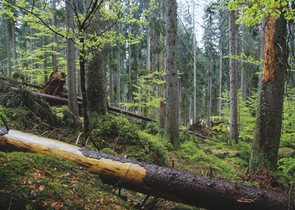Nature Conservation 1/2008 — 26. 2. 2008 — Nature and Landscape Management
Forests in National Parks after the Hurricane Kyrill
Also two National Parks, covered mostly with Norway Spruce (Picea abies) forests, were hit severely (Krkonoše/Giant Mts. 150,000 m3; Šumava/Bohemian Forest Mts. 900,000 m3 of wood biomass damaged). In the Šumava NP, the event restarted the old discussions about the danger of a potential European Spruce Bark Beetle (Ips typographus) outbreak. The article shortly describes the contemporary troublesome situation of the Czech Republic's forestry, led by old-fashioned economic considerations and lacking ecological insight or ecosystem approach. More than 50 % of forests in the country are Norway Spruce plantations, instable to gales and prone to bark beetle outbreaks. In the follow-up, basic scientific information about ecology of Norway spruce forests in Europe is given (forest spatial and age structure, dynamics and succession, regeneration ecology, etc.). The forest management goal in National Parks is spruce plantation conversion into more natural forests of native species. Forests in 1st zones of the National Park are left to nature. In the 2nd zones, a semi-natural management system must be introduced, supported by the appropriate planning methods, scientific information and risk analyses. As facilitators of natural development, pioneer tree species must be given maximum attention in the conversion process. The semi-natural management is a flexible system combining the maximum use of natural processes with an inevitable human manipulation of stands when and where necessary. The management of the 3rd zones has an integrated character, combining various local forest functions (recreation, sports and tourism, etc.). The bark beetle outbreaks are the necessary evil to be reckoned with in spruce monocultures established in the past. Not the bark beetle itself is the primary driver of the difficulties – it, in the fact, is the existence of the large-scale uniform spruce monocultures. The ongoing climate change strengthens the danger of bark beetle outbreaks. Conversion of spruce plantations into more natural forests is quite necessary. After the hurricane Kyrill, an expansion of the bark beetle must be reckoned with not only in National Parks but in the whole country. The outdated forest law does not stimulate tasks and goals of forest management in National Parks. Therefore, development of the appropriate policy and management system for forests in National Parks in the Czech Republic is a matter of the highest urgency.
Název připojené galerie
Quisque egestas velit non nulla fermentum, aliquet pharetra nunc malesuada. Nullam molestie vel diam non tincidunt. Sed pulvinar lacinia nunc et consectetur. Duis varius leo ac ex scelerisque, ullamcorper eleifend massa consectetur. Nullam in metus ac arcu pellentesque venenatis ac id lorem. Nulla nec ipsum sed enim sodales blandit a sit amet ex.







